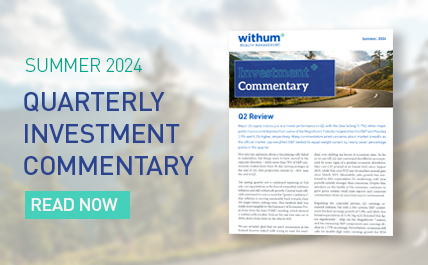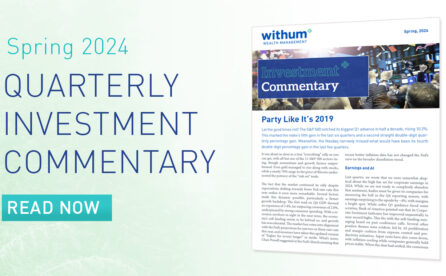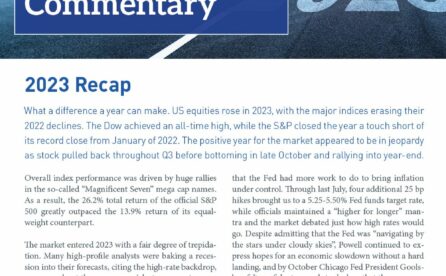
The Quarter in Review: A strong year for the markets
Global equity markets ended the quarter with mixed results as the S&P 500 Index declined 0.4% while the MSCI World ex US Index gained 5.9%. Concerns about the negotiations surrounding the fiscal cliff negatively impacted the U.S. markets for the quarter. For the year, however, markets posted strong gains with the S&P 500 and the MSCI World ex US Index gaining 16% and 16.4% respectively.
US Economy: A pick-up in activity
Growth in GDP picked up during the third quarter of 2012 to an annual rate of 3.1%, up from 1.3% in the second quarter. Due to the high levels of uncertainty related to the fiscal cliff, many corporations delayed hiring and making any major cash outlays. The impact of this will most likely be reflected by weaker GDP numbers for the fourth quarter.
Hurricane Sandy, another Halloween “freak storm”, hit the Northeast with a vengeance. New York, Connecticut and especially New Jersey were affected by Sandy’s path of destruction. Power outages, floods and extensive damage to homes and businesses were widespread. While this had a negative impact on retail sales, it will likely be followed by a pick-up in economic activity in damaged areas as homes and infrastructure are rebuilt in the next 12 to 18 months.
Strength in the housing market continues, as is evident by positive momentum in new and existing home sales. The inventory of available homes remains at multi-year lows, which has helped home prices increase in value. According to the S&P Case-Shiller Price index, home prices rose 4.3% from the twelve months ended October 2012. In addition, home sales continue to be positively affected by the Federal Reserve’s accommodative monetary policies.
The Fed has stated that the period of “exceptionally low” interest rates is now explicitly tied to the unemployment level. It is expected that rates will remain at these levels until unemployment reaches 6.5%, assuming inflation remains subdued. For December, the unemployment rate stood at 7.8% and the U.S economy generated 155,000 jobs-mostly coming from the private sector. For the year, the average number of non-farm jobs created each month was 153,000; a number that is below trend but steady and sufficient to drive consumer spending.
International: Light at the end of the tunnel?
The sovereign debt crisis in Europe is far from being resolved, but was pushed to the back burner during the past couple of months. Worst- case scenarios have been reduced, thanks to the safety net created by the European Central Bank’s purchases of sovereign bonds. Euro zone economic growth continues to decrease but it seems the pace of contraction has slowed. Growth should remain subdued thanks to the fiscal austerity programs put in place.
China seems to have engineered a soft landing. Economic activity picked up, led by infrastructure spending by the government. The new political leadership in China seems to be focused on increasing domestic consumption and decreasing its reliance on exports to stimulate economic growth. This, coupled with the stable growth of some developed economies, should help offset the tepid growth of what appears to be a bottoming Euro zone.
As a whole, emerging markets have started to show improvement that could continue into the New Year.
The US Political Landscape: Unchanged
With the Presidential election behind us, some of the uncertainty facing the U.S. economy has been removed. After millions of dollars were spent on campaigns by both parties, the political landscape remains unchanged; Barack Obama remains in the White House; Democrats retain control of the Senate and Republicans still control the House of Representatives.
The tax deal passed on January 1st, 2013 titled the American Taxpayer Relief Act of 2012 included something for everyone to complain about: Tax hawks decried higher taxes on the wealthy, while many on the left disliked the fact that Bush-era tax cuts were made permanent for most taxpayers. In any case, the new found certainty in tax rates makes matters of investment, estate, and tax planning somewhat easier.
A Look Ahead: The drama continues
More political wrangling over the debt ceiling should take center stage in the next couple of months. A down to the wire agreement for the fiscal cliff sidestepped the full force of the scheduled spending cuts and tax increases set to take effect January 1st, 2013. Congress will still have to deal with the debt ceiling and the remaining fiscal cliff issues in the coming months; hopefully this time reaching a solution for the short and long term fiscal and budgetary problems. Even with the additional revenues that will come from the increase in taxes on the wealthy, there will still be a daunting deficit for 2013. As of today, no significant spending cuts, that would have a meaningful impact on the budget deficit, have been enacted. As we have mentioned previously, we believe addressing these issues is crucial to the long term economic health of our country.
The U.S. economy continues to perform well. Consumer confidence has been improving as the housing market continues to gain ground. Auto sales are strong and personal balance sheets are in better financial shape as most of the consumer de-levering has taken place. On the corporate side, balance sheets are flush with cash, inflation remains subdued and equity valuations are still below their historical mean. As corporations put their enormous cash balances to work, we anticipate above average share buy-backs, dividend increases and mergers and acquisitions activity. This bodes well for the equity market and we remain cautiously optimistic for the coming year, barring any major crisis that could arise.
As always, we welcome your questions and comments.
This quarterly letter was written by the financial advisors at PWM Advisory Group – Private Wealth Management
This article was designed for educational purposes only and is not intended for specific legal, accounting, investment, income tax or other professional advice. Please remember that past performance may not be indicative of future results. Different types of investments involve varying degrees of risk, and there can be no assurance that the future performance of any specific investment, investment strategy, or product (including the investments and/or investment strategies recommended or undertaken by PWM Advisory Group, LLC [“PWM”]), or any non-investment related content, made reference to directly or indirectly in the presented material(s) will be profitable, equal any corresponding indicated historical performance level(s), be suitable for your portfolio or individual situation, or prove successful. Due to various factors, including changing market conditions and/or applicable laws, the content may no longer be reflective of current opinions or positions. Moreover, you should not assume that any discussion or information contained in this presentation serves as the receipt of, or as a substitute for, personalized investment advice from PWM. To the extent that a reader has any questions regarding the applicability of any specific issue discussed above to his/her individual situation, he/she is encouraged to consult with the professional advisor of his/her choosing. PWM is neither a law firm nor a certified public accounting firm and no portion of the presented material(s) should be construed as legal, accounting or consulting advice. A copy of the PWM’s current written disclosure statement discussing our advisory services and fees is available for review upon request. To ensure compliance with U.S. Treasury rules, unless expressly stated otherwise, any U.S. tax advice contained in this communication (including attachments) is not intended or written to be used, and cannot be used, by the recipient for the purpose of avoiding penalties that may be imposed under the Internal Revenue Code. Photo Credit: blmiers2
If You Liked This Article, SHARE IT!
Help Us Spread The Word. Share This Article With Your Friends & Peers


